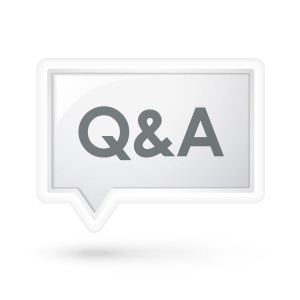You’ve set the meeting, prepared for the meeting, now it’s time to have the meeting. After small talk, move on to your memorized opening statement. Formally introduce yourself and tell a story about how you came to work for your company, what it is that you do and why you do it. Then, ask the customer to tell their story. There’s a good chance you’ll find values that you have in common. This will create rapport and build trust.
Be curious and ask questions. You can’t talk about your solutions until you have diagnosed the problem. You only need to ask a few great questions. Ask questions that will initiate an open-ended dialogue about challenges within their current program.
Asking Questions
Focus your questions on 3 topics:
- The Past – how did they get to where they are?
- The Present – what are they doing now?
- The Future – what are their initiatives and planned changes?
Try not to bounce around. Go through one topic at a time to keep the meeting on track. Remember, you are running the meeting. You determine where you want the meeting to go next.
Here are some examples of questions to ask.
The Past
- How did you come to work for the company?
- What other roles did you have before your current position?
- Tell me how you selected your current supplier.
The Present
- What’s the biggest challenge facing your department today?
- What processes are in place to direct end-users to best value products or services?
- What is it that your current supplier does to help you lower costs?
- Tell me about your best vendor. What is it they do to help make you successful?
- What are your procurement initiatives for this year?
The Future
- What has recently changed, or what are you planning to change that would impact your spending on the product or service that we’re discussing today?
- What do you see as the benefit of consolidating vendors and sourcing from fewer suppliers?
- What are your expectations for the RFP results? What would you like to see?
Other Questions
- How will you compare pricing?
- Besides price, how do you compare vendors in a bid situation?
- If my price is the same as your current supplier, who wins?
- Besides you, who else is involved in making the decision?
Answering Questions
Depending on the client’s answers, you may have an opportunity to tell success stories about customers in similar situations.
When the client asks a question, don’t always answer their question right away. First, ask a question about their question. For example, if you’re in the office products industry, the client may ask, “do you sell tablets on your website.” Instead of giving a 10-minute overview of the tablets that you sell, you can ask if they’re considering replacing laptops with tablets? If you’re right, this will lead to more dialogue. If you’re wrong, the client will reveal the reason they’re interested in tablets, and this will also lead to more discussion. They may even say they don’t want anyone in the company having tablets and that you can’t offer them. Then you can probe further or move on.
Finally, know your value proposition. Be prepared to answer the question, “what is different about your company.” Try to limit it to 2 or 3 major points.
At the end of the meeting, ask what they learned today, what resonated, and then discuss the next steps. I like to have at least one agreed-upon next step. This could be meeting with someone else in their company, a demo of your product or service, reviewing your proposal, etc.
Follow Up
Make a record of what you learned and what you need to do next
Enter your meeting notes in the customer relationship management tool that you use. This information will help you customize your proposal. Create a checklist of the next steps and action items. The checklist will keep you on track to ensure that you do everything you said you would do.
Send the prospect a thank you/summary email
Email the client the next day to outline the action items. This is not only common courtesy, but it holds the client accountable for things they may have committed to in the meeting. Set a date for deliverables. For instance, “I look forward to seeing the supply usage report from you within the next 2 weeks”.
Connect on Linked-In and other social media
Always connect with the client on social media. This provides you with another touchpoint. If your contact is actively interacting on social media, you may also get valuable information from their posts.
“When the client asks a question, don’t always answer their question right away. First, ask a question about their question.”
– Michael Tattersall
That covers it. Now you’re on your way to not only be considered as a potential business partner, but also a trusted resource.
Mindset – Athlete
Think of yourself as an athlete on game day. What do athletes do? They eliminate all distractions and concentrate on the game. Follow the playbook, but consider that you may need to deviate from the plan and run an audible.
Nutrition – Protein Shake
On game day, use your energy should for enthusiasm and thinking. You don’t want your energy to be spent on digesting a heavy meal. Have a light breakfast, like a protein shake that is easy to digest. Drink lots of water early in the day to help keep your vocal cords hydrated.
Essential Oils – Ylang Ylang
The scent of Ylang Ylang is mood-enhancing and energizing. The oil comes from the ylang-ylang flower and has a sweet fragrance. For a boost that will help put you in the right frame of mind, take three deep inhales from the bottle before heading into the meeting.
